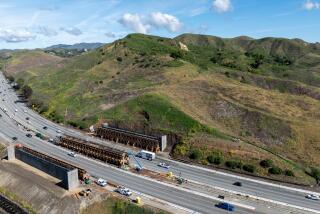Route 66 -- immortalized, but mortal
- Share via
It was, John Steinbeck wrote in “The Grapes of Wrath,” the “Mother Road” of Dust Bowl sharecroppers heading to the promised land of California. It was where George Maharis and Martin Milner got their 1960s kicks in a Corvette and the highway that brought families to Disneyland and the original McDonald’s in San Bernardino.
Immortalized in countless novels, songs and movies, Route 66 was the 2,400-mile road along which adventure seekers meandered from Chicago to the Pacific Coast, bedding down in tepee motels and eating at greasy spoons.
Of the eight states through which Route 66 passed -- the others are Illinois, Missouri, Kansas, Oklahoma, Texas, New Mexico and Arizona -- California is the only one that has not done a cultural survey of the highway.
The California Preservation Foundation and the National Park Service said Monday they want to change that. With $65,000 in funding from the park service, the foundation plans to hire a consultant to document the state’s portion of the Route 66 corridor.
Cindy Heitzman, executive director of the California Preservation Foundation, said an official with the National Park Service Route 66 Corridor Preservation Program broached the subject of a survey in July, and the groups formed a partnership.
“We were the holdout,” Heitzman said, “and this was a wonderful opportunity to complete the survey.”
James M. Conkle, a Route 66 aficionado and activist, said he and others had been promoting the idea of a survey for years. A full survey could cost as much as $650,000, he said.
“It’s not fully funded, but it’s at least a start,” said Conkle, chairman of the Route 66 Alliance, one of several nonprofit groups seeking to promote awareness and preservation of the legendary highway.
The foundation has been meeting with a stakeholders committee that includes representatives from federal and state agencies as well as several Route 66 nonprofit groups, including the Route 66 Alliance and the California Route 66 Preservation Foundation.
The consultant will travel the Route 66 corridor from the Arizona border at Topock to Santa Monica and catalog the different roadside properties, such as diners, motels and attractions, and identify historic themes and key periods of significance.
A 1931 AAA guide indicated that California had 332 miles of U.S. Highway 66 from Needles to Los Angeles, though the road was later extended to Santa Monica. Along the way, the highway passes through Mojave Desert ghost towns and miles of urban sprawl.
The highway, rendered unnecessary by the interstate highway system, was decommissioned in the mid-1980s and much of the living history of Route 66 has vanished as the road has been broadened into suburban thoroughfares.
Still, groups have sprung up to preserve the highway and its history, one with deep connections with the American psyche.
As “roadie” Michael Wallis wrote in his 1990 book “Route 66: The Mother Road”: “Route 66 is Steinbeck and Will Rogers and Woody Guthrie and Merle Haggard and Dorothea Lange and Mickey Mantle and Jack Kerouac. It’s thousands of waitresses, service station attendants, fry cooks, truckers, grease monkeys, hustlers, state cops, wrecker drivers and motel clerks. . . . It’s yesterday, today and tomorrow. Truly a road of phantoms and dreams, 66 is the romance of traveling the open highway.”
A chief goal for the consultant will be to complete at least one nomination for the National Register of Historic Places, said Jennifer Gates, field services director for the California Preservation Foundation and manager of the Route 66 project.
A number of California Route 66 attractions are already listed in the National Register. They include the Aztec Hotel in Monrovia, the Broadway theater and commercial district in downtown Los Angeles and the Colorado Street Bridge in Pasadena.
More to Read
Sign up for Essential California
The most important California stories and recommendations in your inbox every morning.
You may occasionally receive promotional content from the Los Angeles Times.










